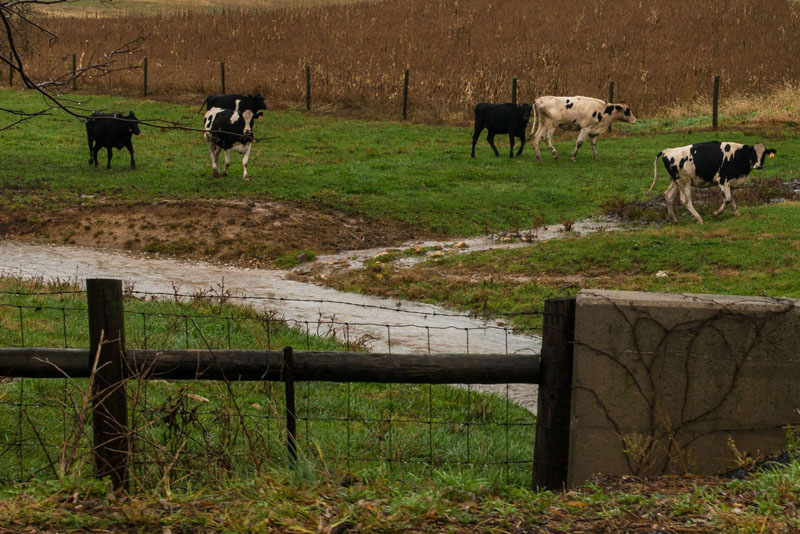Farm runoff, while improved, is still a contributor to poor Chesapeake Bay water quality. File photo from 2007 in Lexington, Ky. Photo by U.S. Environmental Protection Agency.
Forty years of formal efforts to restore the water quality and living resources of the Chesapeake Bay have failed despite the expenditure of more than $12 billion. For 27 years, the Bay states solemnly agreed upon repeated voluntary restoration agreements and failed to comply without Environmental Protection Agency sanctions.
In 2010, the EPA was forced by a court settlement to impose mandatory requirements for Bay states to assure that Bay-choking nitrogen, phosphorus and sediment pollution were reduced. This was to comply with Clean Water Act (CWA) requirements so that 100% of Bay waters met the law’s minimum standards for clean water.
EPA generously gave the recalcitrant states until 2025 to comply or face penalties. As the states fail again by wide margins to meet CWA requirements, a feckless EPA again refuses to impose any sanctions to prod the states into compliance.
Instead, EPA and the Bay state governors decided in 2022 to punt in lieu of ramping up efforts to tamp down the most egregious pollution sources — agriculture and developed land stormwater. They agreed to take two years to “recalibrate” (read delay) and develop a new plan for beyond 2025. The draft issued in July was a real nothingburger.
A Maryland Matters article from the Bay Journal noted the latest EPA two-year milestone evaluation (2022-2023) of state progress acknowledged that only 57% of the required nitrogen reductions were achieved since 1999 and 67% of phosphorus. But newer EPA data established nitrogen reductions were grossly overstated by nearly 50% which the EPA ignored. After nearly 15 years and record spending, states are less than a third of the way toward achieving needed nitrogen reductions.
A Sept. 4 fish kill of 24,000 menhaden and other fish in the Inner Harbor. Already depleted menhaden are a key forage fish for osprey and rockfish. Photo courtesy Waterfront Partnership
This cover-up of the wider margin of failure is typical. It is partially caused by the agricultural sector, the largest source of water-fouling nutrients — 60% of nitrogen and 44% of phosphorous. The culprits are increased farm fertilizer, more farm animals and their excrement, and the ineffectiveness of farm best-management practices despite $2 billion in grants to farmers since 2010.
More than 50 top Bay scientists, advising EPA on Bay restoration, found that there was limited evidence of reductions in phosphorus concentrations or of significant gains in nitrogen reductions, particularly from agriculture and other nonpoint sources. They noted that the best that can be said is that at least the Bay has not gotten worse over the last 40 years. They concluded that throwing more money at farmers for voluntary best management practices has not and will not significantly reduce nutrients — precisely the safe plan still being followed.
Unfortunately, most of the Bay conservation community has gone along with this agricultural strategy as some siphon off millions for their own coffers.
The results are that only 28.1% of the Bay’s waters are unimpaired (not polluted), an improvement of just 1.6% since 1985 when 26.5% of Bay waters were unimpaired. The CWA requires 100% to be unimpaired. Despite all the claims of success and the greenwashing, there is no better indicator of achievement or failure than this data.
Excess nutrients also have led to the proliferation of bacterial flesh-eating diseases threatening both life and limb.
Restoring the Chesapeake’s living resources is at the core of cleaning up our waters. So how are we doing? Gov. Wes Moore wrote to the Secretary of Commerce last year pleading for money because of an “ongoing commercial fishery disaster … Since 2012, landings of seven of Maryland’s marquee commercial fishery species have declined between 27% and 91% … These species dockside value has likewise declined between 12% and 85%.” They include crabs, rockfish, white and yellow perch. The application was denied.
Despite in excess of $450 million spent on oyster restoration, oyster populations remain at 3% of historic levels. Bay grasses are critical to Bay ecosystem functioning but the Bay states’ commitment to achieve 185,000 acres by 2010 stood at only 82,937 acres in 2023, 45% of the goal.
Strikingly, three Bay “leaders” published a Maryland Matters column quoting the misleading EPA nutrient reduction data and repeating overblown claims of success in agricultural pollutants. Their entire column is focused on development land runoff which is a real problem and where little progress is being made. This issue must be better addressed, but the EPA failed to impose any measures to do so.
This urban runoff contributes 7% of all nitrogen flows compared to farms’ 60%. Even EPA’s Ortiz acknowledged there is “still a big gap” in reducing agricultural nutrients which the environmental authors ignored.
When the enforcer (EPA) lies down on the job, and many in the conservation community fail to act or contest this fecklessness, there is no hope for a restored, thriving Chesapeake.

